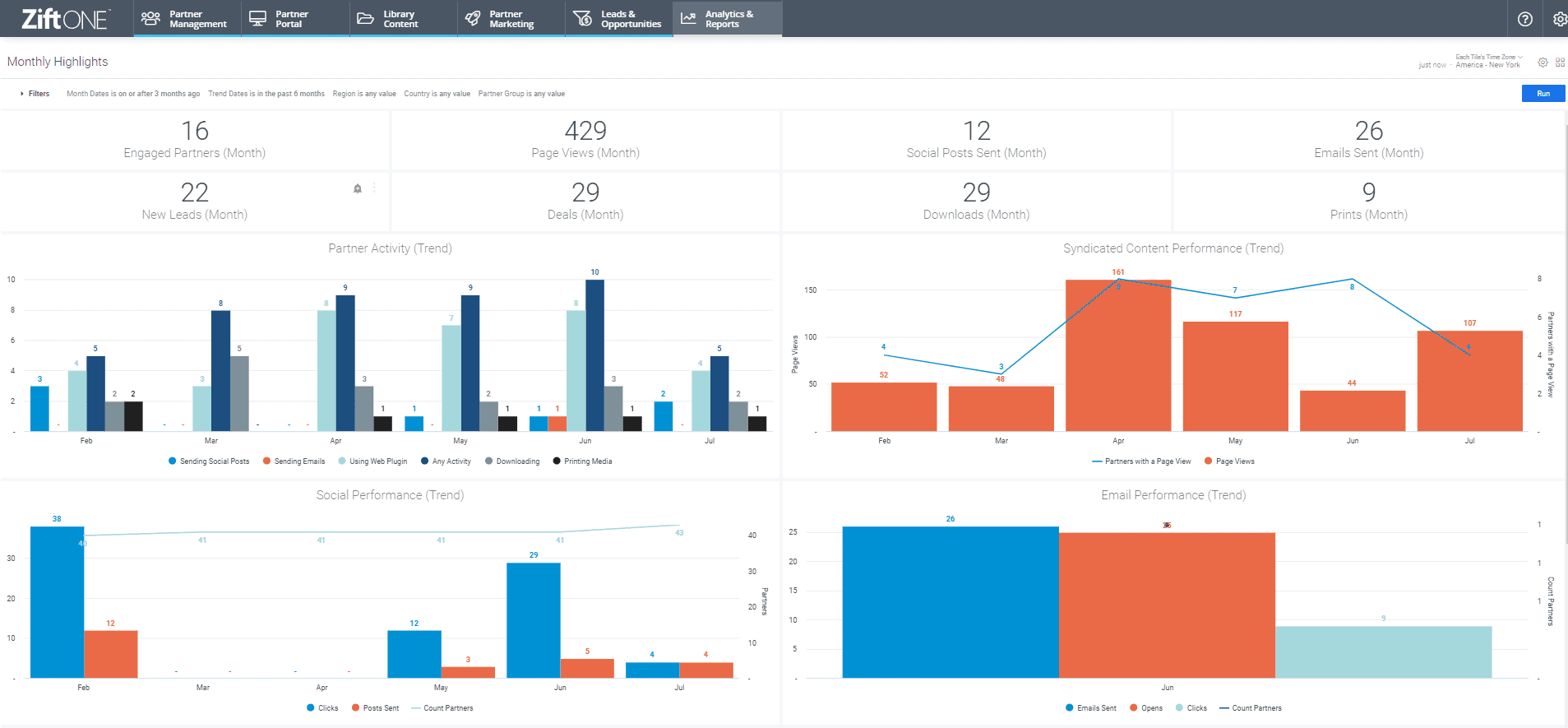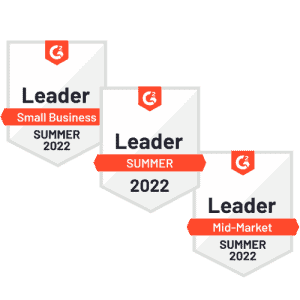- PRM software platforms represent a vendor’s partner program operations, solutions and culture to their partners
- PRM software platforms are key to scaling partner programs.
- Experts expect PRM software platform use to increase this year.
- PRM software platforms enable channel sales leaders to have indirect sales pipeline visibility.
6 Reasons Your Channel Partner Program Needs a PRM Software Platform
PRM software platforms can set your partner program up for success. They bring a comprehensive suite of scalable capabilities that enable you to operate your entire program, whether you have 100 or 10,000 partners.
Making a PRM investment, selecting the right PRM platform, or switching platforms is a major milestone for any partner program; it indicates that you’re serious about dedicating resources and technology to engage and scale your indirect sales channel.
But why do partner programs actually need a software platform? To cover this subject, we interviewed six channel leaders for insight into why they or their clients have used PRMs in their partner programs. Our expert panelists include:
- Nicole Steele, Director of Channel Marketing & Enablement for Cloud-First WAN and security company Aryaka Networks
- Helena Marsikova, Senior Channel Marketing Manager for deep observability company Gigamon
- MeiLee Langley, Senior Director of Worldwide Channel Marketing for cloud-based customer service and digital engagement tools provider LiveVox
- Rachel Turkus, Senior Vice President of Sales & Marketing for mobile cloud-based firewall provider CyberReef
- Khali Henderson, Senior Partner for channel consultancy and technology marketing firm BuzzTheory
- Heather Tenuto, Chief Revenue Officer for partner relationship management (PRM) and channel management platform provider Zift Solutions
Want to skip ahead? Check out six reasons your channel partner program needs a PRM software platform:
- PRM Software is a Single Source of Truth
- A PRM Platform is the Path to Partner Program Scalability
- PRM Software Protects Your Partner Program From Staff Turnover
- PRM Software is Customizable to Fit Your Partner Program Model
- Your CRM Software Can’t Take the Place of a PRM Platform
- A PRM Platform Provides Indirect Sales Pipeline Visibility and More
What is Partner Relationship Management (PRM) Software?
Partner Relationship Management (PRM) software is an application used to manage partnerships between organizations and their indirect sales channel partners (e.g., affiliates, agents, brokers, dealers, distributors, value added resellers, managed services providers, etc.)
PRM software streamlines and strengthens partner program business processes to deliver mutual sales growth for providers and their indirect selling partners by:
- Organizing and orchestrating data
- Storing and sharing assets
- Tracking indirect sales transactions
- Qualifying indirect sales partners for program incentives and promotions
- Facilitating ordering and provisioning of provider solutions to partner-sourced end customers
The most common capabilities of PRM software platforms include:
- Storing shared resources in a content management system (CMS)
- Integrating with customer relationship management (CRM) software and popular third-party applications
- Distributing provider-sourced and partner-sourced leads
- Tracking allocation and use of marketing development funds (MDF)
- Tracking and attributing promotions for select partners, partner types and product lines
- Analyzing financial performance, such as detailed pricing and sales data
- Enabling (TCMA)
- Housing a library of partner sales and marketing materials, such as:
-
- Flyers and data sheets
- Battlecards
- Blogs
- Case studies
- eBooks
- White papers
- Presentations
- Videos
- Podcasts
- Webinars
- Events
- Digital campaigns
- Social campaigns
-
- Centralizing KPIs, partner data and administrative functions on a dashboard
- Enabling deal registration for partners to claim leads
- Training and certification on how to sell, order, provision and procure provider services akin to a Learning Management System (LMS)
- Processing and fulfilling orders
6 Reasons Your Channel Partner Program Needs a PRM Software Platform
We got to the core of why channel partner programs should use a PRM software platform with our experts and uncovered six key reasons.
1. PRM Software is a Single Source of Truth
Our expert panelists across the board viewed PRM platforms as the basis of their partner program.
LiveVox’s MeiLee Langley says, “Our PRM (Partner Portal) is the foundation upon which we have built our Partner Program. We use the PRM or Partner Portal as the one-stop shop for our partners to engage and do business with LiveVox, including deal registration, account management, training, collateral, demand-gen campaigns, MDF and more.”
Gigamon’s Helena Marsikova echoes this sentiment, “PRM platforms are a one-stop shop for vendors and partners to be successful together. They provide a solid foundation for channel programs and offer partners all the tools they need to be enabled and go running.”
Langley elaborates that the best PRM software offers utility and convenience that are vital to partner engagement. “As we suppliers strive to be ‘easy to do business with,’ it is imperative that we aggregate as many systems, tools and platforms into a single location, so partners don’t need to remember multiple URLs and logins.”
Rachel Turkus of CyberReef extends the impact of the PRM beyond the partner program, explaining that the PRM represents your entire company to partners. “A good PRM system will create your partner program culture and your company culture will be communicated through it. The PRM effectively [provides] a baseline understanding to partners of how your program works, how your products work and how your company works.”
BuzzTheory’s Khali Henderson points out that a PRM instantly communicates the breadth and depth of resources behind your partner program. “In the same way your website is the face of your business to end customers, your PRM is the face of your program to partners. It’s your identity. If your partner program is without a PRM platform, it’s like your company being without a website. Can you make indirect sales and function without the PRM platform? Yes, but much like not having a website, you’ll likely lose out on revenue opportunities.”
Zift Solutions’ Tenuto also says not having a PRM is a competitive disadvantage in today’s marketplace. “If you’ve not invested in a PRM, you risk looking ‘small,’ especially if market-leading competitors have had them for several years. Appearing ‘small’ and under-resourced brings up a host of uncomfortable questions from partners about your capacity to serve customers, the size of your staff, your geographical reach, the reality of your 24/7/365 support commitment and how you’re reliably tracking partner deals if no partner management system is in place.”
2. A PRM Platform is the Path to Partner Program Scalability
Our panel repeatedly pointed to digital transformation, mainly due to the COVID-19 pandemic, as a driving force in PRM software adoption for partner programs. Scaling a partner program in a post-Covid economic environment requires online and digitally focused methods for partners to engage with your program. PRM software meets this new requirement.
Aryaka’s Nicole Steele also points to the need for providers to offer accessible systems for partners to engage at times outside the standard ‘9 to 5′ workday. “With the work from anywhere or anytime, partners will require the use of tools that fit their own schedules and priorities,” she says.
LiveVox’s Langley adds that partners are looking for online self-service options to engage with providers. “As partners get busier and they sign with more suppliers, they seem to want more freedom to self-serve requests instantly,” she says. “Partners seem to want to access training, create marketing campaigns or co-branded collateral, and even see and manage their pipeline and booking reports on their own schedule.”
Langley also attributes the need to compete in a digital-first selling environment as another driver of PRM software use for partners. “Marketing and demand-gen tools [are] a big benefit of many PRMs, [and] as the demand for digital engagement increases in this post-Covid environment, partners seem to want to increase their utilization of these tools and are turning to suppliers’ PRMs,” she says.
CyberReef’s Turkus also points to the pandemic as having forced vendors’ partner programs online to scale. “COVID-19 increased the use of PRMs. Looking back at last year in 2021, if partner programs didn’t already have a program strategy using PRMs, they’d have developed it. This year, in 2022, we see an increase in the reengaging of previous PRM systems used in years past.”
Zift Solutions’ Tenuto notes that scalability is critical for partner programs, especially for partners selling volume-based services. “Most partner programs aim to scale and recruit a high number of partners to keep the pipeline full,” she says. “There are some exceptions depending on vendor business models and target accounts, but generally, it’s a numbers game at play, especially since not all partners will be productive. You can’t scale at a reasonable pace to service hundreds or potentially thousands of partners without a PRM software platform in place automating program processes for you.”
3. PRM Software Protects Your Partner Program From Staff Turnover
It’s no secret that the information and communications technology (ICT) channel is rife with constant personnel turnover, especially with channel account managers switching companies every 18 months. While you want to replace these front-line positions as quickly as possible, short-term vacancies won’t make or break your program if you have a high-quality PRM platform in place.
CyberReef’s Turkus identifies that PRMs should enable partners to get core sales process components, like quoting, without needing to engage a supplier employee. “A good PRM allows a quote to be made without involving a salesperson, channel manager or partner success manager (PSM). Ideally, the PRM will create a funnel for a channel manager or PSM on its own, provided [the channel team has trained] partners on quoting, deal registration and order processing.”
Additionally, Turkus cautions vendor channel sales teams against underestimating the importance of the PRM and advises them to use it to create program continuity. “Channel salespeople may believe they’re the missing piece of the partner program that can unlock newfound indirect sales success for the company,” she says. “Salespeople change; a good PRM does not.”
She adds that vendors should require channel teams “to take the time to learn the program channel management systems, like a PRM, and then evangelize and train on it with partners. The channel is a relationship-based business, but it’s not just relationships the channel manager brings to the table; they need to bring a willingness to learn new systems like PRMs.”
4. PRM Software is Customizable to Fit Your Partner Program Model
Partner programs have various business models for all types of partners, some of which include:
- Affiliate Partners – Affiliate partners have cultivated access to an audience uniquely invested in a specific topic and follow them to understand and keep up to date with that subject. Alliance partners typically will earn commissions.
- Referral Partners – Referral partners typically send a prospective customer to a vendor and receive a one-time commission for each closed deal.
- Agent Partners – Agent partners receive recurring commissions for sold deals. They typically perform all sales and marketing functions while the vendor performs the deployment and provides the service to the end customer.
- Distributors – Distributors and technology services brokerages (TSBs) aggregate partners for vendors and vendors for partners. This takes away administrative headaches for vendors in managing with partners, and partners typically get higher compensation and greater protection than they would on their own.
- Value Added Resellers (VARs) – VARs, or solutions providers, get a vendor product at wholesale, add a profit margin and sell it to end customers with their own value-added services or solutions over the top.
- Service Delivery Partners – A service delivery partner enhances the value of a vendor solution by providing presales consulting, installation and management of services to customize them to end customers’ unique needs.
- Technology Alliance Partners – Technology alliance partners offer complementary technology to the provider’s solution. This partnership combines two (or more) products or services as a solution for the end customer.
- Fulfillment Partners – Fulfillment partners help providers manage administrative and contractual needs of selling products at scale. These partners primarily manage order fulfillment of a high volume of transactions at a low rate.
- Cloud Service Providers – Cloud service providers offer an element of cloud computing (IaaS, SaaS or PaaS) through hosting a vendor solution in the cloud to improve speed, security, flexibility and other forms of optimization.
- Managed Service Providers (MSPs) – Managed service providers will proactively remotely manage end customer IT infrastructure, typically under a monthly or annual subscription model. MSPs frequently function as a form of outsourced IT and would layer a vendor solution into the tech stack they offer the end customer.
- White-label Resellers – Also called wholesale partners or private-label resellers, white-label resellers will take a wholesale provider solution and sell it to their customers as their own solution under their brand. White-label resellers typically encompass a partner profile of traditional resellers, VARs and MSPs – so they can fit into more than one partner type.
- Original Equipment Manufacturers (OEMs) – OEMs embed provider products into their own solutions and sell them to end customers under their own brand, just like white-label partners.
- Global Systems Integrators (GSIs) – GSIs build computing systems by combining vendors’ hardware, software, networking, and storage products and solutions.
- Strategic Partners – Strategic partners will fit the role of multiple partner types listed above, but these will typically be partners that deliver the most revenue and provide the most direction and input to vendor strategies.
“PRMs, at least the good ones, can conform to several different partner program models,” says Zift Solutions’ Tenuto. “With some types of models, the program almost literally can’t function without a PRM system of some kind in place. Take a wholesale program, for instance – a white-label partner needs to be able to order services at will and then immediately communicate timelines for deployment to an end customer as if it’s their own service. You can only get fast turnarounds at scale like that through the automation that technology like PRM platforms provide.”
Our panel agrees that quality PRMs are customizable for different program business models and cater to how you work. Keeping this in mind, they also say it’s essential to be discerning in selecting a PRM that actually fits your program model, as not every PRM platform is the same.
CyberReef’s Turkus’ extensive experience with PRMs at various types of providers has made this top-of-mind, “Matching the partner program culture with the correct PRM out the gate is often the first and biggest hurdle,” she says. “If you choose a PRM that doesn’t match how you operate, then the needs of your program and the capabilities of the PRM won’t match. Some PRMs don’t allow for funneling at the distributor or TSB level. If your program revenue relies entirely on engaging with TSBs and their subagents, and a major TSB can’t log in and see what’s going on, then there is no sense in using that PRM for your program.”
Turkus argues this extends even to features you may believe are helpful but won’t actually be utilized by your team. “If you choose a PRM to use its mass emailing function for channel salespeople, but your channel sales team doesn’t do mass emailing, then that’s an issue,” she says.
Turkus also points out that simply because one PRM was effective at your previous company doesn’t mean it will be a great fit for your current employer. She says, “Marketing may bring in a PRM platform from a prior company where they had a great experience, but if the partner sales models between those two programs don’t quite match, then you can run into obstacles getting your internal team and partners to use the platform.”
5. Your CRM Software Can’t Take the Place of a PRM Platform
A common hang-up for newer partner programs entering the channel and considering whether to adopt a PRM software platform is that they already have a CRM. Decision-makers may wonder why their company’s partner program can’t simply use their CRM to track deals, email to recruit and manage partners, etc. The problem is that a CRM isn’t purpose-built for partners and is not on par with a PRM platform’s capabilities.
Aryaka’s Nicole Steele explains, “Many companies try and leverage their CRM as a PRM…and there are so many more aspects of a PRM than a contact repository. True PRM solutions will provide enablement, demand generation, deal registration, content library and much more. Most importantly, PRM solutions can provide the data necessary to showcase which partners are leveraging the tools so you can adjust to ensure partners take the right actions at the right times.”
Gigamon’s Marsikova concurs. “CRM software only offers a fraction of all the capabilities a PRM software brings to the table,” she says. “If built properly from end to end, it helps with new partner recruitment, ramp up and enablement, provides means of communication, sales and marketing support, business management and if sprinkled with gamification features, it also motivates and rewards.”
CyberReef’s Turkus agrees. “CRM is for your salespeople to manage their funnel, commissions and deals. PRM is for partners to manage their funnel and access marketing materials,” she says. “[They are] two completely different audiences with different aims.”
That said, Steele, Marsikova and Turkus advocate the PRM you’re looking for needs to integrate with your CRM, here’s why:
Steele says, “Data! Good data in – good data out! By syncing the information from your PRM with your CRM, you can gain deeper insights into your partners’ activities.”
Marsikova points out that PRM-CRM integrations offers a 360-degree view of your entire operation. “It just perfectly connects the three vertexes of a triangle – the vendor, the customer and the partner,” she says.
Turkus adds that both the CRM and PRM need to map to each other to reflect sales commissions and deal attribution correctly. She explains: “If all sales are going through your CRM, then having them map into PRM is important, so the entire sales process is automated. There is no manual data entry from CRM to PRM. The source of truth between both systems needs always to be your CRM when it comes to sales figures as the CRM is often where commissioning is done.”
6. A PRM Platform Provides Indirect Sales Pipeline Visibility and More
How do you determine whether your partner program is successful? There are many factors, but sales and pipeline are at the top of the list. However, partner programs face a high hurdle of tracking deals, proposals, prospects, leads and each stage of a sales funnel from hundreds or thousands of partners. Tasking channel managers to manually monitor and track these metrics isn’t efficient.
PRM software platforms are the key to providing your program with the information you need for proper sales and pipeline forecasting. PRMs are equipped with analytics dashboards and report generation functionality that makes it easy to gauge the success of your partner program. The PRM software delivers sales pipeline visibility across your partner base.
Zift Solutions’ Tenuto elaborates: “Let’s be honest, your partners don’t necessarily want to log into yet another vendor’s partner portal and register their deals. But you both have something the other wants – you want their deals and their sales data to forecast pipeline and revenue accurately, and they want credit for deals won to get SPIFF payouts, earn MDF, qualify for President’s Clubs, and enter the running for your quarterly or annual sales contests. A PRM platform can be the way you make all that tracking happen by building it into your program structure.”
BuzzTheory’s Henderson adds that it’s more than just pipeline, “Entire program initiatives and resources, including marketing materials and campaigns, can be tracked inside the PRM. Some of these sales enablement resources can take months and tens of thousands of dollars to develop. The PRM can give you the visibility you need to see how your partners are using them and determine whether there’s ROI on your efforts.”
Below is an example of a dashboard showing analytics from ZiftONE:

All in, it’s clear that PRM software platforms are a vital tool for any partner program looking to automate, scale and take their indirect sales revenue to the next level.

Zift is honored to be ranked a leading provider of Partner Relationship Management by G2, the largest software marketplace with unbiased, validated buyer reviews.
With ZiftONE, you can align your channel marketing, sales and operations like never before.
We’d be happy to show you how our platform and team can help your channel partner program. Contact our team to learn more today.
Laz Gonzalez
Laz Gonzalez is Chief Strategy Officer at Zift Solutions. A prominent industry analyst and thought leader, Gonzalez brings unparalleled channel expertise to Zift and has served as strategic adviser to leading B2B channel programs worldwide.




